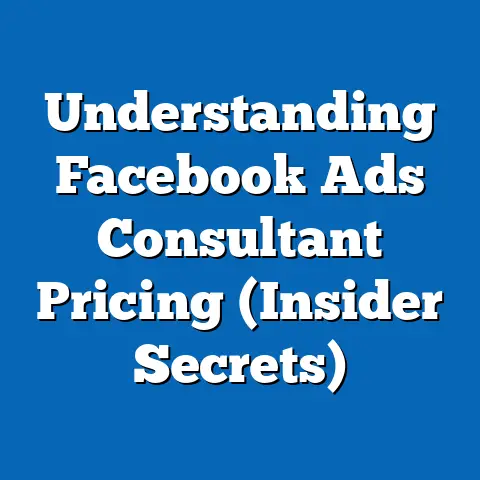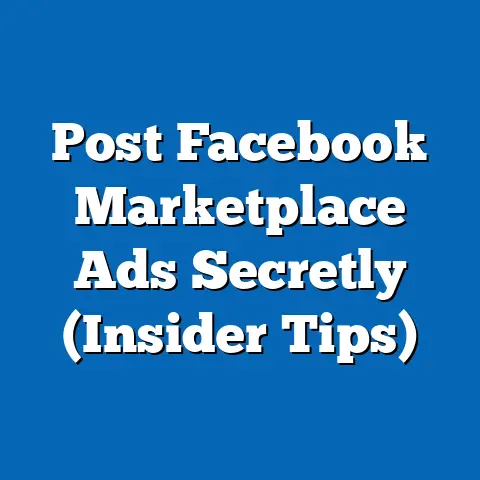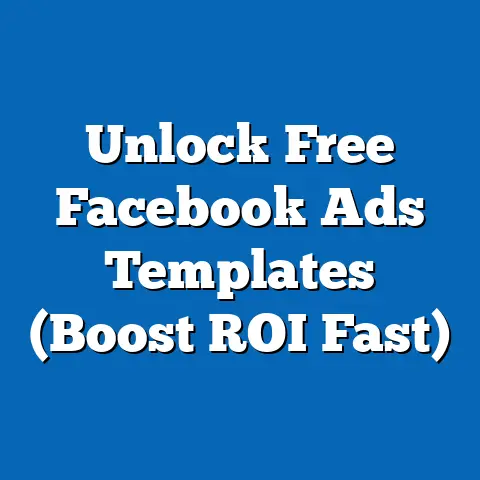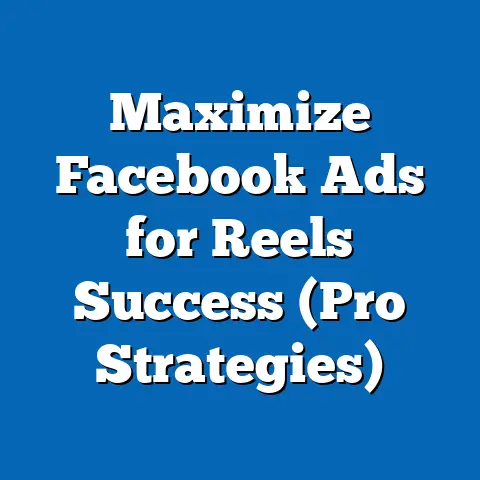Boost List Growth with Facebook Ads (Proven Strategies)
Boost List Growth with Facebook Ads: Proven Strategies in the Context of Technological Innovation and Generational Dynamics
Introduction: The Intersection of Technology and Audience Engagement
In the rapidly evolving landscape of digital marketing, technological innovations have fundamentally reshaped how businesses connect with their audiences. From the advent of social media platforms to the rise of sophisticated advertising algorithms, technology has provided tools that allow for unprecedented precision in targeting and engagement. Among these tools, Facebook Ads stand out as a cornerstone for businesses aiming to grow their email lists—a critical asset for sustained customer relationships and revenue generation.
Section 1: Technological Innovations in Digital Marketing
The Evolution of Digital Advertising
The journey of digital advertising began in the mid-1990s with the first clickable banner ad, which appeared on HotWired.com in 1994, marking the birth of online marketing. This rudimentary form of advertising laid the groundwork for what would become a multi-billion-dollar industry. By the early 2000s, search engine marketing emerged with Google AdWords, introducing a pay-per-click model that prioritized relevance and user intent.
The launch of Facebook in 2004, followed by its advertising platform in 2007, represented a seismic shift in digital marketing. Unlike earlier platforms that focused on broad reach, Facebook Ads leveraged user data to enable hyper-targeted campaigns based on demographics, interests, and behaviors. This innovation coincided with the proliferation of smartphones and mobile internet, which further amplified the platform’s reach and effectiveness.
Key Defining Characteristics of Tech-Driven Marketing
Modern digital marketing, epitomized by platforms like Facebook, is characterized by personalization, scalability, and real-time analytics. Personalization allows advertisers to craft messages that resonate with specific audience segments, while scalability ensures that campaigns can be adjusted to fit budgets of any size. Real-time analytics provide immediate feedback on ad performance, enabling marketers to optimize strategies on the fly.
Another defining feature is the integration of artificial intelligence (AI) and machine learning, which power tools like Facebook’s algorithm for ad delivery and audience targeting. These technologies analyze vast datasets to predict user behavior, ensuring ads are shown to those most likely to engage. This level of precision was unimaginable in the early days of digital advertising and underscores the transformative impact of tech innovation.
Historical Context: From Mass Media to Micro-Targeting
Historically, marketing relied on mass media channels like television and print, which offered limited targeting capabilities and minimal feedback on audience response. The shift to digital platforms in the late 20th and early 21st centuries introduced a paradigm of micro-targeting, where individual preferences could be addressed directly. Significant events, such as the 2008 U.S. presidential election—where Barack Obama’s campaign famously utilized social media for voter outreach—highlighted the potential of digital tools to influence behavior at scale.
The societal implications of this shift are profound. On one hand, micro-targeting empowers businesses to build meaningful connections with consumers; on the other, it raises ethical concerns about data privacy and manipulation, as evidenced by the 2018 Cambridge Analytica scandal involving Facebook. These events have shaped public discourse around digital advertising and underscored the need for transparency and regulation.
Section 2: Understanding Facebook Ads as a List-Building Tool
The Mechanics of Facebook Ads
Facebook Ads operate within a robust ecosystem that includes the Ads Manager platform, where marketers can create, manage, and analyze campaigns. The platform offers a variety of ad formats—such as image ads, video ads, carousel ads, and lead ads—each designed for specific objectives like brand awareness, engagement, or conversions. For list growth, lead ads are particularly effective, as they allow users to submit their contact information directly within the ad without leaving the platform.
Facebook’s targeting capabilities are a cornerstone of its effectiveness. Marketers can define audiences based on demographics (age, gender, location), interests (hobbies, pages liked), and behaviors (purchase history, device usage). Additionally, features like Custom Audiences and Lookalike Audiences enable businesses to target existing customers or find new users who resemble their best leads.
Why List Growth Matters
An email list is a direct line of communication between a business and its audience, offering higher engagement rates compared to social media posts. According to a 2022 report by HubSpot, email marketing generates an average return of $36 for every $1 spent, making it one of the most cost-effective channels. Growing a list through Facebook Ads not only expands this reach but also ensures that the leads are pre-qualified based on targeting criteria.
However, building a list is not without challenges. Privacy regulations like the General Data Protection Regulation (GDPR) and the California Consumer Privacy Act (CCPA) have imposed strict rules on data collection, while Apple’s iOS 14.5 update in 2021 limited tracking capabilities, impacting ad performance. Marketers must navigate these constraints while maintaining user trust.
Section 3: Proven Strategies for Boosting List Growth with Facebook Ads
Strategy 1: Crafting Compelling Lead Magnets
A lead magnet—an incentive offered in exchange for contact information—is the foundation of any list-building campaign. Effective lead magnets address a specific pain point or desire of the target audience, such as an eBook, checklist, webinar, or discount code. For example, a fitness brand might offer a free workout plan, while a software company could provide a downloadable guide to productivity tools.
When promoting lead magnets via Facebook Ads, the ad copy and visuals must clearly communicate the value of the offer. Use action-oriented language like “Download Now” or “Get Your Free Guide,” and pair it with high-quality images or videos that grab attention. Testing multiple variations of the ad creative through A/B testing can help identify what resonates most with the audience.
Strategy 2: Leveraging Lead Ads for Seamless Conversions
Facebook Lead Ads simplify the process of capturing contact information by pre-filling forms with user data from their profiles. This reduces friction and increases conversion rates, especially on mobile devices where typing is less convenient. Marketers can customize forms to collect specific information, such as email addresses, phone numbers, or even answers to qualifying questions.
To maximize effectiveness, ensure the lead ad is targeted to a relevant audience and includes a clear call-to-action (CTA). Follow up promptly with leads via automated email sequences to nurture their interest. According to a 2021 study by Marketo, businesses that nurture leads see a 20% increase in sales opportunities compared to those that don’t.
Strategy 3: Utilizing Lookalike Audiences for Scalability
Lookalike Audiences allow marketers to reach new users who share characteristics with their existing customers or leads. By uploading a list of high-value contacts (e.g., past purchasers or email subscribers), Facebook’s algorithm identifies similar profiles to target. This strategy is particularly effective for scaling list growth while maintaining relevance.
However, success depends on the quality of the source audience. A small or unrepresentative list may yield poor results, so focus on building a robust initial dataset. Additionally, refine targeting by layering demographic or interest-based criteria to ensure alignment with campaign goals.
Strategy 4: Retargeting for Higher Conversion Rates
Retargeting involves showing ads to users who have previously interacted with a brand—such as visiting a website, engaging with a post, or abandoning a form. These warm leads are more likely to convert, with studies showing that retargeted users are 70% more likely to complete a purchase (Criteo, 2020). For list growth, retargeting can remind users to claim a lead magnet they showed interest in.
Implement retargeting by installing the Facebook Pixel on your website to track user behavior. Create tailored ads that address the specific action the user took (e.g., “Still interested in our free guide?”). Be mindful of ad frequency to avoid overwhelming users, as overexposure can lead to annoyance.
Strategy 5: Optimizing for Mobile and Video Content
With over 98% of Facebook users accessing the platform via mobile devices (Statista, 2023), optimizing ads for smaller screens is non-negotiable. Use vertical or square formats for images and videos, ensure text is legible without zooming, and keep CTAs prominent. Mobile-friendly lead forms are also critical to prevent drop-offs during submission.
Video content, in particular, drives higher engagement on mobile, with 60% of users more likely to watch a video than read text (Facebook Insights, 2022). Create short, captivating videos (15-30 seconds) that highlight the value of the lead magnet. Include captions, as many users watch videos without sound.
Section 4: Generational Dynamics and Ad Receptivity
Generational Characteristics and Technology Adoption
Generational differences play a significant role in how audiences respond to digital advertising. Baby Boomers (born 1946-1964), shaped by post-World War II prosperity and the rise of television, often value trust and reliability in marketing messages. They may be less comfortable with digital platforms but are increasingly active on Facebook, particularly for staying connected with family.
Generation X (born 1965-1980), a cohort that bridged analog and digital eras, tends to be pragmatic and skeptical of overt marketing. They value authenticity and are more likely to engage with ads that offer clear, practical benefits. Meanwhile, Millennials (born 1981-1996), who grew up with the internet, prioritize experiences and social impact, often responding to ads that align with their values.
Gen Z (born 1997-2012), the first fully digital-native generation, is highly visual and mobile-focused, with short attention spans shaped by platforms like TikTok. They are drawn to interactive, authentic content but are also wary of data privacy, often scrutinizing how brands use their information. Understanding these nuances is critical for tailoring Facebook Ad campaigns.
Economic and Social Influences on Engagement
Economic factors, such as income levels and financial priorities, influence how generations interact with ads. For instance, Millennials, many of whom entered the workforce during the 2008 recession, often prioritize cost-effective solutions, making free lead magnets particularly appealing. In contrast, Gen Z, facing student debt and economic uncertainty, may be more selective, engaging only with brands that demonstrate genuine value.
Social and cultural trends also shape ad receptivity. Gen Z’s emphasis on diversity and inclusion means they are more likely to engage with brands that reflect these values in their messaging. Baby Boomers, influenced by traditional gender roles and societal norms of their formative years, may respond better to conventional imagery and language, though this varies widely based on individual experiences.
Implications for Campaign Design
Marketers must adapt Facebook Ad strategies to generational preferences while avoiding stereotypes. For Baby Boomers, focus on clear, benefit-driven messaging and build trust through testimonials or endorsements. With Gen X, emphasize authenticity and avoid overly promotional tones, while offering practical incentives.
For Millennials, align campaigns with social causes or experiential benefits, and use storytelling to create emotional connections. Gen Z requires visually striking, concise content that feels native to social media, paired with transparency about data usage. Testing and segmentation are essential, as even within generations, diversity in values, behaviors, and tech adoption exists.
Section 5: Societal and Ethical Implications of Data-Driven List Growth
Privacy and Trust in the Digital Age
The use of Facebook Ads for list growth raises significant societal questions about data privacy and consumer trust. High-profile incidents like the Cambridge Analytica scandal have heightened public awareness of how personal data is used in advertising. Regulations like GDPR and CCPA aim to protect users, but compliance adds complexity to marketing efforts.
Marketers must prioritize transparency by clearly disclosing how data will be used and offering opt-out options. Building trust is not just a legal necessity but a competitive advantage—consumers are more likely to share information with brands they perceive as ethical. A 2022 Edelman Trust Barometer report found that 81% of consumers consider trust a deciding factor in purchasing decisions.
Economic Impacts on Businesses and Consumers
From an economic perspective, effective list growth through Facebook Ads can drive significant revenue for businesses, particularly small and medium enterprises (SMEs) that rely on digital channels for customer acquisition. Email lists enable cost-effective, direct communication, reducing dependency on paid ads over time. However, the costs of running ads and complying with privacy laws can be prohibitive for smaller players, potentially widening the gap between large corporations and SMEs.
For consumers, data-driven marketing can enhance relevance and convenience but also risks creating echo chambers where individuals are exposed only to tailored content. This phenomenon, often linked to algorithmic bias, can limit exposure to diverse perspectives and reinforce existing beliefs, with broader societal implications for polarization.
Workplace and Cultural Shifts
In the workplace, the reliance on digital tools for list growth reflects broader cultural shifts toward data literacy and tech proficiency. Marketing teams must adapt to evolving platforms and regulations, necessitating continuous learning and upskilling. This trend is particularly pronounced among younger workers (Millennials and Gen Z), who are often tasked with driving digital innovation.
Culturally, the normalization of data collection in exchange for personalized experiences has reshaped consumer expectations. While older generations may view this with suspicion, younger cohorts often accept it as a trade-off for convenience. Bridging these generational divides requires marketers to balance personalization with respect for privacy across all demographics.
Section 6: Challenges and Limitations in Using Facebook Ads for List Growth
Platform-Specific Challenges
Despite its strengths, Facebook Ads come with inherent challenges. The platform’s algorithm prioritizes user experience, often limiting the reach of ads deemed irrelevant or overly promotional. Marketers must invest in high-quality content and precise targeting to avoid wasted spend, a task complicated by frequent updates to ad policies and features.
Additionally, the iOS 14.5 update, which restricts tracking via Apple’s App Tracking Transparency framework, has reduced the accuracy of audience targeting and attribution. This has led to higher costs per lead for many advertisers, with some reporting a 20-30% increase in acquisition costs (Forbes, 2021). Adapting to these changes requires diversification into other channels and a focus on first-party data collection.
Audience Fatigue and Ad Saturation
As more businesses leverage Facebook Ads, users are increasingly exposed to marketing content, leading to ad fatigue. This manifests as lower engagement rates and higher costs per click, particularly in competitive industries. To combat this, marketers should prioritize creative refreshment—regularly updating ad visuals and copy—and explore less saturated ad placements, such as Instagram Stories or Facebook Marketplace.
Measurement and Attribution Issues
Accurately measuring the success of list growth campaigns is another hurdle. While Facebook provides robust analytics, attributing conversions solely to ads is challenging in a multi-touchpoint customer journey. Users may interact with multiple channels (e.g., organic social media, search ads) before subscribing, making it difficult to isolate the impact of Facebook Ads. Implementing multi-touch attribution models and integrating CRM tools can help address this gap.
Section 7: Future Outlook and Emerging Trends
The Role of AI and Automation
Looking ahead, AI and automation will continue to shape Facebook Ads and list growth strategies. Advanced machine learning models will enhance predictive targeting, enabling even more precise audience segmentation. Automation tools, such as dynamic ads that adjust content based on user behavior, will streamline campaign management and improve efficiency.
However, the increasing reliance on AI raises questions about transparency and accountability. As algorithms become more complex, understanding how decisions are made—and ensuring they align with ethical standards—will be critical. Marketers must stay informed about AI developments while advocating for responsible use.
Shifts in Generational Behavior
Generational dynamics will also evolve, with Gen Z and the emerging Generation Alpha (born 2013 onward) driving new trends in digital engagement. These cohorts, raised on immersive technologies like augmented reality (AR) and virtual reality (VR), may expect more interactive ad experiences. Facebook’s parent company, Meta, is already investing in the metaverse, hinting at future advertising formats that blend virtual and physical worlds.
Older generations, too, will adapt to technology at varying paces, influenced by socioeconomic factors and access to digital resources. Marketers must remain agile, continuously researching audience behavior to anticipate shifts rather than relying on static assumptions.
Regulatory and Ethical Horizons
The regulatory landscape for digital advertising is likely to tighten, with more countries adopting privacy laws similar to GDPR. This will push businesses toward privacy-first strategies, such as zero-party data collection (where users voluntarily share preferences) and contextual targeting (based on content rather than personal data). Facebook itself may introduce features to align with these trends, though the impact on ad effectiveness remains uncertain.
Ethically, the industry faces pressure to address misinformation and manipulative advertising practices. Collaborative efforts between platforms, regulators, and businesses will be essential to rebuild public trust while maintaining the benefits of data-driven marketing. The balance between innovation and responsibility will define the next decade of digital advertising.
Conclusion: Navigating the Future of List Growth with Facebook Ads
Boosting list growth with Facebook Ads offers immense potential for businesses seeking to build direct, lasting connections with their audiences. By leveraging proven strategies—such as compelling lead magnets, lead ads, lookalike audiences, retargeting, and mobile optimization—marketers can achieve significant results. However, success requires an understanding of technological innovations, generational nuances, and societal implications that shape the digital marketing landscape.
From the historical shift from mass media to micro-targeting to the ethical challenges of data privacy, the context of Facebook Ads is as complex as it is dynamic. Generational differences highlight the need for tailored approaches, while emerging trends like AI, the metaverse, and stricter regulations point to an evolving future. As we move forward, the ability to adapt to these changes while maintaining trust and relevance will separate successful marketers from the rest.
Ultimately, the path to effective list growth lies in balancing innovation with responsibility. By staying attuned to technological advancements, audience preferences, and ethical considerations, businesses can harness the power of Facebook Ads to build not just lists, but meaningful relationships. While uncertainties remain, the opportunity to shape the future of digital engagement is within reach for those willing to navigate this multifaceted terrain with insight and integrity.





